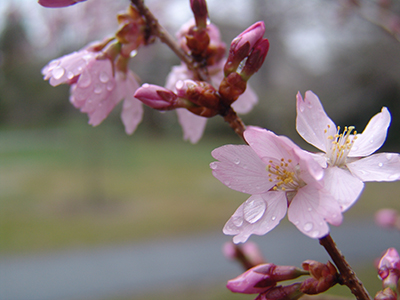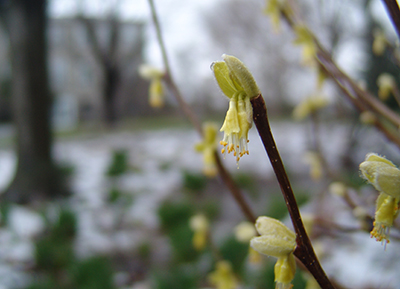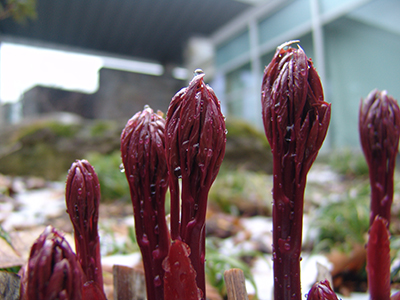
Plants of the Week: April 2

Prunus ‘Dream Catcher’
When the cherry border begins to display bright clouds of pink and white, one can be sure that spring is imminent. At Swarthmore, one of the first to bloom is always Prunus ‘Okame’ and the closely related cherry cultivar Prunus ‘Dream Catcher’.
According to sources, P. ‘Dream Catcher’ was selected as a seedling from an open-pollinated Prunus ‘Okame’ in the late ‘70s. The seedling was an early bloomer and seems to show floral characteristics reminiscent of its maternal grandparent, Prunus incisa, except with notably pink petals.
Also of interest is the bark streaked with orange lateral striations that are made up of dense groupings of lenticels. Photo credit: J. Bickel

Dirca palustris
Dirca palustris is a small, deciduous shrub in the family Thymelaceae (along with Daphne and Edgeworthia) that is native to the understories of Eastern United States woodlands.
Every year in early spring, the shrub produces a multitude of small, unassuming flowers. The pendulous flowers are soft light yellow and emerge in twos and threes, backed by a pair of downy, nascent leaves. The corollas of the small flowers are diminutive and fused into a narrow sheath from which the pistil and stamens protrude.
A.W. Smith’s Dictionary of Plant Names notes that the genus comes from the Greek word meaning “fountain.” The species name literally translates to “marsh-loving” in Latin, denoting the plant’s preferred habitat. A few specimens can be found growing at the northeast corner of Kohlberg Hall. Photo credit: J. Bickel

Paeonia ‘Coral Charm’
The Harry Wood Garden on the north side of campus is home to several cultivars of herbaceous peonies. Granted, April is an unlikely time to highlight peonies, but today I was struck by the deep burgundy-red of the emerging foliage, reaching from the ground like thick lipstick-colored asparagus. The color and shape suggests something that belongs attached to a coral reef (although not likely the source of the cultivar name). Paeonia ‘Coral Charm’ is noted for its large, doubled, coral flowers that will appear in a few months. Photo credit: J. Bickel





No Comments